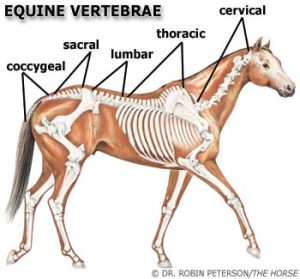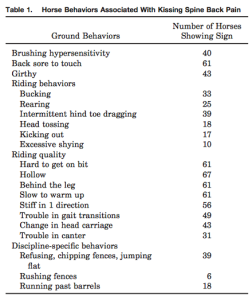
Kissing Spines and Back Pain in Horses
Did you know the equine health condition in our competition picture? If not, not to worry, you’re in the right place! A passion for us here at Equi-Ice is to educate you guys, the readers, about a variety of different horse topics, and how important they are to the health of your horse.

If you look closely at the x-ray, you can see only a small amount of gapping between each bony structure inside the circle (as opposed to the left hand side of the picture). One could also say, that those bony structures are ‘kissing’.. The answer? Kissing spines! (Or Over Riding Dosral Spinous Processes). A condition most commonly affecting the thoracic vertebrae (mostly T10-18) of a horse, where the space between the spinous processes of affected vertebras begins to narrow.

There are five grades of severity for kissing spines, with grade one being mild narrowing of the spinous processes, to grade five, complete fusion. Generally speaking, the closer the two spinous processes are on radiograph, the more likely it is to be clinically significant.
Signs and symptoms can include both behavioural and performance problems for your horse. They can range from a degree of severe lameness, to only subtle changes in your horse. Your horse may feel stiff through the back and/or hind-quarters, and may refuse to drop and round their head and neck. Horses with kissing spines will often exhibit a pain response when touching their back, or when saddling. When asking your horse to canter, it may feel disunited, or they may resist accepting the bit. Your horse may also have a change in temperament, such as they may begin bucking or rearing.
Some things your veterinarian or physiotherapist may look for include:
- prominent spinous processes (larger ‘bumps’ along your horses spine)
- associated muscle spasm
- muscle wastage
- reduced range of motion of the spine
- strength of your horse’s abdominal muscles
- inflammation of the involved or nearby structures
- gait examination for lameness, reduced movement and/or flexibility
Diagnosis of kissing spines can be done by your veterinarian through a variety of different imaging techniques, which can all provide valuable information. Kissing spines can occur simultaneously with a variety of other conditions/lesions of the spine, and so it is very important to take in the whole clinical picture.
Dr Tracey A. Turner (DV, MS, Diploma ACVS) evaluated 212 horses in a study to look at the diagnosis, treatment and outcome of kissing spines. Out of 4407 horses, 310 were identified with back pain, whilst 68% percent of those horses (212) had kissing spines. Turner’s study divided these horses into three groups; horses with kissing spines and back pain, back pain with no kissing spines, and a control group (no kissing spines or back pain). From comparing these groups, Turner noted that there are more likely to be clinical problems in thoroughbreds, dressage horses, horses less than 5 years of age, and horses with more than 5 vertebras involved. Turner also stated that the presence of kissing spines made a horse three times more likely to have back pain. It was also noted, that over 50% of horses were used for dressage. A logical assumption for this, is that dressage horses are asked to perform movements that require a lot of mobility and flexibility. Extracted from Turner’s study, Table 1 summaries the horse behaviours they found associated with kissing spines.

Physiotherapy can help to alleviate the back pain your horse may experience through a range of treatment options. This can include releasing surrounding muscle spasm through dry needling, soft tissue release, and the application of heat and stretches. Range of motion exercises are also a great way to ensure that mobility and movement of your horse’s spine is preserved, including lateral flexion and flexion. Core exercises can also help to support your horse’s back by building strength through the abdominal muscles. Think pilates for horses! Icing is also a fantastic treatment technique for your horse to reduce inflammation, pain and muscle spasm. Providing heat to the surrounding muscles prior to exercise (given there is no inflammation) and icing post exercise, is a great treatment tool to give your horse the best recovery.
Part of the reason why I have developed Equi-Ice, is to help treat kissing spines. Over the past decade as working as an equine physiotherapist, I saw a need for a product that could be used to help treat horses with back pain. If you want to find out more about the products, you can head here.
It is also important to understand that the presence of kissing spines is not necessarily a cause for concern, but should be noted, monitored and kept considered as a predisposing factor for back pain in your horse. If you are ever in doubt, it is always best to consult your veterinarian or equine physiotherapist for opinion and management.
We hope this helps your understanding of kissing spines. Keep an eye out for our next Who Know’s Best competition!
Physio Tom.
